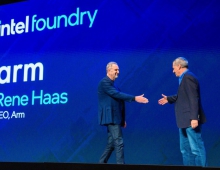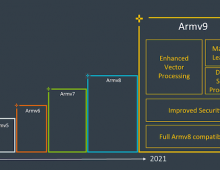
ARM Targets Automotive and Industrial Control Markets With The ARMv8-R Architecture
ARM has disclosed technical details of its new ARMv8-R architecture for real-time embedded processors for use in automotive electronics and other integrated safety and control applications.
The ARMv8-R architecture builds on the heritage of the 32-bit ARMv7-R architecture used for the company?s Cortex-R series of real time processors and complements the ARMv8-A architecture announced in 2011.
The ARMv8-R architecture specification will enhance ARM's real time 32-bit processor solutions with new features to expand their functionality and capability . In particular, processors implementing the ARMv8-R architecture will be suitable for the safety-related applications in automotive and industrial control.
A key innovation within the ARMv8-R architecture is the introduction of a 'bare metal' Hypervisor mode which enables programmers to combine different operating systems, applications and real-time tasks on a single processor whilst ensuring strict isolation between them. This facilitates software consolidation and re-use which will accelerate time-to-market and reduce development costs.
In addition, the ARMv8-R architecture will enable overall improvements in software quality and will support sophisticated embedded programming techniques such as model-based automated code generation.
The deployment of ARMv8-R architecture will reduce costs, increase efficiency and improve performance of embedded systems to support emerging automotive applications such as Advanced Driver Assistance Systems and Vehicle to Vehicle communications as well as factory automation applications and Human-Machine Interface. For example, a microcontroller incorporating an ARMv8-R processor could host Linux for graphical management and networking functions together with real-time operating system workloads such as motor control.
The ARMv8-R architecture also permits coexistence of both virtual memory and protected memory systems on the same processor enabling an Operating System using memory management, such as Linux, to be integrated with a Real Time Operating System. Ecosystem support for the ARMv8-R architecture is anticipated in a number of Operating System products including INTEGRITY from Green Hills Software, Nucleus from Mentor Graphics, and T-Kernel from eSOL. These integrated hardware and software solutions will be capable of supporting stringent automotive and industrial interoperability and safety standards, including AUTOSAR, ISO 26262 and IEC 61508.
Other ARMv8-R architecture features include:
- Improved memory protection scheme which substantially reduces context switching time
- ARM NEON advanced SIMD instructions for significantly improved image signal processing tasks
- Instructions carried over from the ARMv8-A architecture such as CRC (Cyclic Redundancy Check) for use in detecting the corruption of program code or data.
The ARMv8-R architecture specification will be available to ARM's partners under license.
The ARMv8-R architecture specification will enhance ARM's real time 32-bit processor solutions with new features to expand their functionality and capability . In particular, processors implementing the ARMv8-R architecture will be suitable for the safety-related applications in automotive and industrial control.
A key innovation within the ARMv8-R architecture is the introduction of a 'bare metal' Hypervisor mode which enables programmers to combine different operating systems, applications and real-time tasks on a single processor whilst ensuring strict isolation between them. This facilitates software consolidation and re-use which will accelerate time-to-market and reduce development costs.
In addition, the ARMv8-R architecture will enable overall improvements in software quality and will support sophisticated embedded programming techniques such as model-based automated code generation.
The deployment of ARMv8-R architecture will reduce costs, increase efficiency and improve performance of embedded systems to support emerging automotive applications such as Advanced Driver Assistance Systems and Vehicle to Vehicle communications as well as factory automation applications and Human-Machine Interface. For example, a microcontroller incorporating an ARMv8-R processor could host Linux for graphical management and networking functions together with real-time operating system workloads such as motor control.
The ARMv8-R architecture also permits coexistence of both virtual memory and protected memory systems on the same processor enabling an Operating System using memory management, such as Linux, to be integrated with a Real Time Operating System. Ecosystem support for the ARMv8-R architecture is anticipated in a number of Operating System products including INTEGRITY from Green Hills Software, Nucleus from Mentor Graphics, and T-Kernel from eSOL. These integrated hardware and software solutions will be capable of supporting stringent automotive and industrial interoperability and safety standards, including AUTOSAR, ISO 26262 and IEC 61508.
Other ARMv8-R architecture features include:
- Improved memory protection scheme which substantially reduces context switching time
- ARM NEON advanced SIMD instructions for significantly improved image signal processing tasks
- Instructions carried over from the ARMv8-A architecture such as CRC (Cyclic Redundancy Check) for use in detecting the corruption of program code or data.
The ARMv8-R architecture specification will be available to ARM's partners under license.





















